| Reviews & Columns |
|
Reviews DVD TV on DVD Blu-ray 4K UHD International DVDs In Theaters Reviews by Studio Video Games Features Collector Series DVDs Easter Egg Database Interviews DVD Talk Radio Feature Articles Columns Anime Talk DVD Savant Horror DVDs The M.O.D. Squad Art House HD Talk Silent DVD
|
DVD Talk Forum |
|
|
| Resources |
|
DVD Price Search Customer Service #'s RCE Info Links |
|
Columns
|
|
|
Hunger Games: Catching Fire (Three-Disc Target Exclusive), The
Lionsgate Home Entertainment // PG-13 // March 7, 2014
List Price: $39.99 [Buy now and save at Amazon]
The Film:
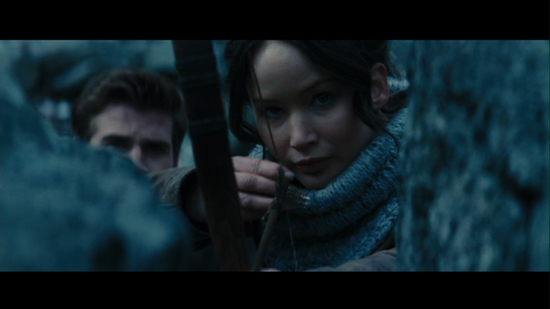
Time to eat a little bit of crow. When I Am Legend and Water for Elephants director Francis Lawrence was tapped to take over duties for The Hunger Games franchise following the departure of Oscar nominee Gary Ross, some skepticism surfaced over whether the adaptations would continue to meet the heights achieved by the invigorated and largely faithful -- not to mention wildly-popular -- first film. Despite being entertaining-enough movies in their own right, neither of Lawrence's previous book-to-screen projects have strong reputations for their closeness to the source material, leaving confidence up in the air for Catching Fire, the daunting middle entry in Suzanne Collins' dystopian trilogy of young-adult books. Those suspicions appear to have been premature, though: not only has this continuation of Katniss Everdeen's saga of rebellion, spectator manipulation, and conflicted love matched the initial film that ignited the spark, it confidently surpasses its predecessor in nearly every way possible, from craftsmanship and faithfulness to sheer exhilaration.
The story picks up half a year after the events of The Hunger Games (watch out for spoilers for the first film), amid the biting cold of winter in District Twelve. Victor Katniss (Jennifer Lawrence, Silver Linings Playbook) has struggled to get her life back to normal -- especially involving her best friend, Gale (Liam Hemsworth, Triangle) -- following her time in the mandatory to-the-death arena, which will complicate further as she goes on tour with the unexpected second victor, her feigned boyfriend Peeta (Josh Hutcherson, The Kids Are All Right, to the other districts in a display of the Capitol's power. Before that, she's greeted by President Snow (Donald Sutherland, Don't Look Now), the authoritative leader of Panem, who suggests that he knows the depth of her deceit during the games, how she and Peeta manipulated the system and spectators into letting them both live for the sake of love. Her resistance to the Capitol during the games has sparked rebellions in response to the yearly Reaping and class structure, something she's forced to calm if she wants to keep her family and friends alive. Katniss, still a blunt and standoffish teenager, must choose to either play the Capitol's game or step up as a figurehead for the rebellion, with Snow ready to respond either way.
Catching Fire boldly roots into darker material by first centering on Katniss' mental integrity and moral constitution, delving deeper into the character's psyche than in The Hunger Games. Her experiences in the arena, the murder of other children and the joy derived from their brutality by the audience, manifest into a form of post-traumatic stress that the film actively explores, hinged on a blistering performance from Jennifer Lawrence as the burgeoning freedom fighter. The Oscar-winning actress' inherent heart-on-sleeve candor becomes crucial to realizing Katniss' internal trauma, commanded by the manic and fearful energy in her reactions as she sees violent images that aren't there and awakens in the night to harrowing dreams. There's a subtler melancholy behind her presence as well, though: the understated glances she shares with her maturing sister Prim (Willow Shields), her rekindled friendships with Peeta and Gale, and how she jolts her drunken mentor, Haymitch (Woody Harrelson, Zombieland), out of his stupor reveal a young woman bottled up with a cocktail of cynicism and desperation, justifiably unready for the challenges ahead.
Adapted from Collins' second book in ways that perhaps outdo even the text, those challenges consist of an uptick in the story's themes about authoritarian government and police enforcement, rendering a harsher dystopian atmosphere as Katniss and Peeta traverse the districts. Granted, director Lawrence can only go so far with depictions of brutality in a PG-13 film aimed at broader audiences, but Catching Fire certainly captures the bleakness and simmering intensity of a burdened nation on the brink of revolution, down to underscoring the volatile events -- the bloodshed -- catalyzing their fury. The work the production crew have done in shaping Central Georgia's locations to fit this bleak but arresting vision are constantly spectacular: the desolate and hopeless atmosphere of the industrial districts, held at gunpoint by white-clad peacekeepers, funnel towards the candy-coated center of privilege benefiting from their destitution, the Capitol. Where the first film emphasized the harrowing spectacle of the games with addled camerawork, the second focuses on the disparity and anxiety between social classes through Limitless cinematographer Jo Willems' steady, stunning gaze at Panem and its denizens.
Director Lawrence has his own challenge to handle with the book's story, since it'd be easy -- and not unjustified -- to look at Catching Fire's return to the arena for more bloodshed as an auspicious rehash, in a franchise that already deals with the baggage of emulating the likes of Battle Royale in its design. Katniss' resignation to death and the participants in the Games themselves, all previous victors with their own idiosyncrasies, give the plot the alternate perspective needed to mask the similarity. Revisiting the media exploitation and pop-culture critiques on reality shows are made intriguing by Katniss' bleak self-assurance and the collective passion of the elder participants, while the building of alliances and training exercises invite those watching into the minds of past tributes. Clearly, there's more to them than meets the eye: Sam Claflin lends suspicious magnetism to the chiseled, primped gladiator Finnick, while Jena Malone's embodiment of the rebellious axe-wielding whackjob Johanna Mason adds a clever parallel to Katniss' quieter and stoic resistance. The road to the arena might be similar, but it's an entirely different ballgame once they're at the Capitol.
In the arena, all of Catching Fire's alternate attributes come to a head, leading to vastly more engaging and visually alluring action beats created by a wide array of dynamic threats, both human and not. The jump to the big screen aids the activity in Collins' text in becoming clearer, which could get overly hectic and jumbled at times. Francis Lawrence's prowess as an action director shines in the complex combination of practical and digital effects, coming together in the tropical aquatic atmosphere in fast-moving, dangerous ways. The renegade flames and dogs from the first film were only the tip of the iceberg: the tricks up the sleeves of new gamemaker Plutarch Heavensbee (a reservedly charismatic Philip Seymour Hoffman) play directly into the deadly reality-show spectacle that the narrative so richly critiques, the shock and awe at his fingertips adding visceral surprises around every corner. Yet it's all part of the book's thrilling beats, the script taking very few liberties with the way the games go down. Shot almost entirely with IMAX cameras for breathtaking scope, it's an exhilarating forty-five minutes that buries the previous film's arena experience (something that can't really be said about the books).
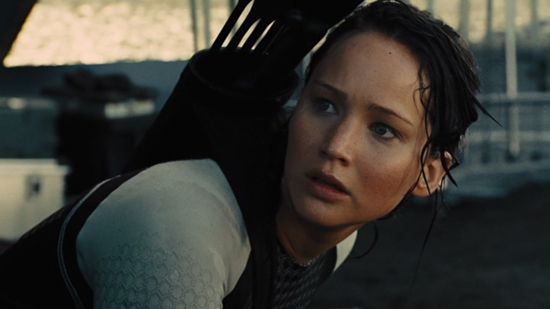
There's also a veil of mystery, of suspicious moves and countermoves, going on within the games in Catching Fire, building towards a bittersweet lead-in to the final chapter(s) of The Hunger Games saga, and a fruition point in Katniss' journey towards becoming the face of the uprising against the Capitol. Sticking close to the source material ensured that the film would, ultimately, end on a cliffhanger that leaves questions only answerable by the next installment and, without doubt, feeling like a bridge between installments. Yet, even under those limitations, this adaptation finds a way to visibly underline Katniss' personal development across this individual story, in a rewarding and inspiring final burst as the film's final words hang in the air. That's what happens with a clear grasp on the source material, and it's really exciting to behold how Francis Lawrence not only maintained the strengths and spirit from the franchise's origin point in a reputable sequel, but improved upon them in surprising, reverent ways that make one eager to storm the castle alongside this girl on fire in the next one.
The Blu-ray:
Left: Standard Two-Disc Blu-ray; Right: Target Exclusive Three-Disc Blu-ray

Click Each Link for Larger Photos of Target's Exclusive Blu-ray: Complete; Slipcover Off; DVD Bonus Disc.
The Hunger Games: Catching Fire has ascended onto Blu-ray from Lionsgate Home Entertainment in an commonplace two-disc arrangement, with Disc One being a loaded high-definition disc and Disc Two covering the DVD side for portability and legacy decks. The standard release is attractive but fairly standard with a cardboard slipcover replicating the theatrical poster artwork on the front and promotional shots on the back, carrying over the one-sheet design to the discs themselves. Slips promoting the books have been tucked under the hubs, along with an Ultraviolet Digital Copy slip for download purposes. Despite being generic, it makes for a fairly attractive regular package.
The folks at Target, on the other hand, have attempted to match the exclusive they released for the first Hunger Games with a deluxe package, which comes in a Digibook-like case containing tight cardboard-paper sleeves for the discs. Promotional images manipulated with fire accents and pinkish-red hues adorn the inside, featuring Katniss, Gale, Peeta, and Finnick. Unfortunately, this exclusive only comes in DVD-sized packaging, so it'll be a bit taller than the other release and might not fit on one's shelf. Furthermore, a Bonus Disc (discussed later in the review) fills up the third slot in the package; however, in keeping with the all-encompassing streamlined aims with the exclusive, the disc is a standard-definition DVD instead of a Blu-ray. Target's design may be distinctive and include extra material only found on this release, but it's got a few points going against it. Note that the first two discs, the Blu-ray and DVD, are identical between both copies, and that the DVD features a fixed 2.35:1 aspect ratio (along with the director's commentary and deleted scenes).
Video and Audio:
Those who were left feeling hollow after the purposefully erratic cinematography of The Hunger Games will really have their fill with Catching Fire, especially on Lionsgate's remarkable Blu-ray. There are two sides of the coin to the presentation, the first being standard Panavision Super-35 footage that photographer Jo Willems notes was shot on film because of the format's rich, somewhat flawed presence and grain structure, presented here at 2.35:1. The result, which covers everything except the lion's share of the footage during the games themselves, marvelously reflect that perspective: a very nice layer of film grain drapes over impressive fine detail in close-ups and in Katniss' modish garments; complex contrast during the stony industrial-district sequences and in the seasonal wildness stay solid and deep; and the incredibly vibrant colors once the setting reaches the Capitol and tribute training ground. Skin tones are responsive to the natural lighting captured in the photography, while the shine of metal and digital atmospheric touches -- snowflakes, fire embers, tumbling transparent blocks -- convey their textural touches without a hitch.
Then, shortly after Katniss enters the arena, the shift happens. Catching Fire's aspect ratio opens up to a screen-filling 1.78:1 to annotate when the IMAX footage begins, and it's one of the slickest and seamless ways of handling an in-film cinematography shift that I can imagine. From there, the already-strong picture quality goes up several notches in the tropical setting of the games, highlighted by unbelievably verdant foliage and radiant sun-drenched lighting. Textures are everywhere, from dark craggy walkways to grains of sand and trickles of sweat, and the elevated resolution and expanded viewing area render some of this format's most stunning images. There are one or two caveats, namely in how the darker scenes struggle with contrast at times, never to a point where details are completely crushed but enough to obscure. The beauty achieved through the IMAX footage vastly outweighs any reservations, though, resulting in some truly stunning moments between the characters that reveal exactly what the high-definition format is all about. Despite having one or two slight flaws, it's become one of my favorite transfers on the format ... and only partially for how it handles the ratio switch.
The Master Audio track has a lot to live up to while accompanying this visual treatment, but all eight channels of the 7.1 high-definition surround design are up to the task. The sounds of branches snapping and turkeys gobbling from multiple channels proves to be an accurate reflection of the immersive activity to come, where atmospheric effects maintain a crystal-clear, natural balance in replicating the bustle of revolutionary crowds and the lively sounds of a tropical jungle. Certain sound effects leading up to the arena hit forcefully, like the sound of a handgun and the pop of fireworks, while environmental effects like the rumble of fire and the rush of a train's movement showcase incredible awareness of the soundstage. Once in the arena, the activity gets more vigorous: the ferocious crash of waves, the searing of flesh, the fury of animals, and the pop of lightning aggressively, and successfully, give the lower-frequency channels a workout. Dialogue has its moments of sounding a little thin and imbalanced against the engaging score and insistent ambiance, but it's a mild hiccup in what's ultimately a fierce sonic delivery on Blu-ray. English, SDH, and Spanish subtitles are available, as well as a Spanish Dolby 5.1 option and a late-night optimized English 2.0 track.
Special Features:
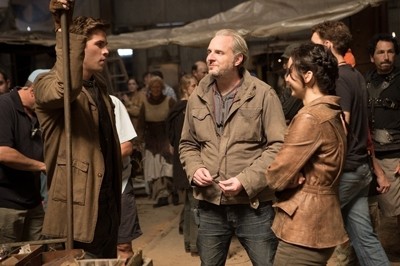 Commentary with Francis Lawrence and Nina Jacobson:
Commentary with Francis Lawrence and Nina Jacobson:
This is one instance where I recommend watching the commentary after viewing the other making-of material, because the discussion from director Lawrence and producer Jacobson works better at filling in gaps not covered or lightly-covered elsewhere. Notably, early in the track, the pair touch on the one chunk of scenes that weren't shot around Georgia and Hawaii, from the biting cold of Jersey and a brief cameo to enhancing Katniss' PTSD with a pertinent addition. In general, this methodical and relaxed commentary almost intentionally pinpoints smaller elements that the big documentary avoids: recasting the cat, mildly rearranging and staying faithful to the book and its themes (including discussion about a certain pocket watch!), closely working with Suzanne Collins' extensive lore for atmosphere and geographical accuracy, focusing on the power in Jennifer Lawrence's performance, and discussing a unique choice for one of director Lawrence's favorite scenes. You have to tiptoe around one or two mild spoilers about the future Mockingjay films in the discussion, but it's nothing worth sweating over. Some material becomes redundant in communication with the documentary, but it's a very solid, relaxed, and insightful track that pays attention to a lot of the minor details that'll be appreciated by both film enthusiasts and fans of the book.
Making of Catching Fire (2:24:55, 16x9 HD):
When looking at the extras for Catching Fire, one might see the label "9-Part Making-Of Documentary" and expect this to be like other Blu-ray discs, where probably around a half-hour or so of press-kit material gets chopped up in segments and made to exaggerate its depth and elaboration. This isn't the case for Catching Fire, though: the documentary, roughly as long as the movie itself (longer if you don't consider the credits), edits together interviews and behind-the-scenes material for an incredible cogent, in-depth look at all the facets of assembling the film. Producer Nina Jacobson and director Francis Lawrence lead the charge touching on the material, usually offering straightforward introductions into individual topics -- casting, shooting locations, visual effects -- and then letting the BTS footage tell the story, often with the production team and actors elaborating on what's being discussed in between takes. The piece understands its target audience, rarely getting too technical with the content so they don't lose the attention of casual viewers, but you get a strong, appreciative sense of the work that went into Catching Fire once it's finished. Here are the timecodes for each segment:
The most significant takeaway from this documentary comes in how they've morphed locations around Atlanta and central Georgia to fit Panem's dystopian atmosphere, both in their discovery of workable locations and the extensive usage of visual effects out of Double Negative's studio, complete with VFX progression and comparisons. Alongside that, the pieces also emphasize how tightly-knit this group of actors have become, how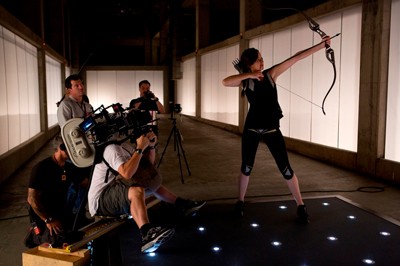 they've embraced Francis Lawrence's replacement of Gary Ross -- something openly discussed -- and how they've physically prepared for their roles through exhaustive combat training. Elizabeth Banks' passion for the trilogy of novels really shows alongside footage of her experimenting with Effie Trinket's attire, which feeds directly into discussion about new costume designer Trish Summerville and her excellent work, both her personal perspective and where she obtained garments externally.
they've embraced Francis Lawrence's replacement of Gary Ross -- something openly discussed -- and how they've physically prepared for their roles through exhaustive combat training. Elizabeth Banks' passion for the trilogy of novels really shows alongside footage of her experimenting with Effie Trinket's attire, which feeds directly into discussion about new costume designer Trish Summerville and her excellent work, both her personal perspective and where she obtained garments externally.
While there's far more satisfaction and congratulation in the participants' tone, it's not entirely without some honest negativity about the production's demands, especially around capturing the arena sequences at a freezing, not-so-clean water park and the loudness of filming with IMAX cameras. Secondary details like the construction of Katniss' bow to the casting of the villainous tributes and getting WETA Workshop's assistance for animal VFX show off how in-depth the content becomes, along with a peek at the scoring and editing processes during post-production. And, indeed, there are a handful of new interview bits (three, I believe) with Philip Seymour Hoffman, about his fondness for the cast and his character. Altogether, with the clear behind-the-scenes footage and time-progression bits, it's a magnificent look at essentially every facet of this production.
Lionsgate Home Entertainment have also included a batch of Deleted Scenes (4:35, HD) with this release, which only garner some passing interest. There are only two of note: one involves an extended conversation between President Snow and gamemaker Plutarch Heavensbee about the origin of mockingjays (and the jabberjays appearing later in the film) that would've been a welcome addition, and another that features Philip Seymour Hoffman in a no-dialogue stretch of material where he walks towards a vault and torches an envelope. No, fans of the book: unfortunately, none of them involve a certain pocket watch, though the commentary confirms that they did actually shoot the scene and, validating a theory of mine, left it out because it would have been too big of a hint. A Sneak Peek at Divergent (6:43, HD) has also been thrown on the disc, essentially an extended version of the film's first trailer with interviews from director Neil Berger and author Veronica Roth elaborating on their enthusiasm.
Target's Exclusive Bonus DVD:
Target's bonus disc is a source of frustration, as parts of it are both recommendable to Blu-ray audiences and not. At first blush, the disc reveals three new sections to explore that mirror the documentary's rhythm of interviews and behind-the-scenes footage: The Alliance (14:27, 16x9) covers the central cast members and their experiences in continuing into a second film; Friend or Foe (18:24, 16x9) delves into characters new and old whose allegiance to the tributes is questionable; and One Vision (12:37, 16x9) hones in on adapting Suzanne Collins' novel as accurately as possible. Upon watching each one, some of the content becomes literally and figuratively redundant, where some of the interviews with the filmmakers and cast have been repeated from the making-of documentary, while becoming prone to retelling the plot and emphasizing the characters/themes. However, there are also some unique interview bits here, notably from Woody Harrelson in The Alliance about his enjoyable rapport with the cast and from Philip Seymour Hoffman in Friend or Foe about his experience in reading Collins' trilogy and working with Donald Sutherland. The entire forty-five minutes of content isn't really worth the time, but those savory new bits are.
Final Thoughts:
Let's keep this section relatively brief: Catching Fire is not only a better film than The Hunger Games, a surprise considering my misgivings towards Francis Lawrence as director, but it's also a better adaptation of the source that even comes dangerously close to overshooting Suzanne Collins' text. It's exhilarating, polished, and deftly telegraphs its themes about government oppression, media exploitation, and the inspiration of one person's voice within a dystopian nation. Jennifer Lawrence takes the strengths of her version of Katniss Everdeen to greater heights through her post-trauma psychosis and altered perspective on survival, deftly guiding her audience through the circus of a tribute's tour, the prospect of reentering the games, and shouldering the burden of becoming the face of an uprising. Lionsgate's Blu-ray is tremendous: the audiovisual quality rocks on many different levels, notably in how it handles an aspect ratio shift, and the supplements -- including a feature-length documentary and a commentary -- are extensive and pretty terrific. Chalk it up, either the standard release or the Target exclusive, to DVDTalk's Collector Series, because it's become a standout example of what the format's able to do with a popular blockbuster.
Thomas Spurlin, Staff Reviewer -- DVDTalk Reviews | Personal Blog/Site

Time to eat a little bit of crow. When I Am Legend and Water for Elephants director Francis Lawrence was tapped to take over duties for The Hunger Games franchise following the departure of Oscar nominee Gary Ross, some skepticism surfaced over whether the adaptations would continue to meet the heights achieved by the invigorated and largely faithful -- not to mention wildly-popular -- first film. Despite being entertaining-enough movies in their own right, neither of Lawrence's previous book-to-screen projects have strong reputations for their closeness to the source material, leaving confidence up in the air for Catching Fire, the daunting middle entry in Suzanne Collins' dystopian trilogy of young-adult books. Those suspicions appear to have been premature, though: not only has this continuation of Katniss Everdeen's saga of rebellion, spectator manipulation, and conflicted love matched the initial film that ignited the spark, it confidently surpasses its predecessor in nearly every way possible, from craftsmanship and faithfulness to sheer exhilaration.
The story picks up half a year after the events of The Hunger Games (watch out for spoilers for the first film), amid the biting cold of winter in District Twelve. Victor Katniss (Jennifer Lawrence, Silver Linings Playbook) has struggled to get her life back to normal -- especially involving her best friend, Gale (Liam Hemsworth, Triangle) -- following her time in the mandatory to-the-death arena, which will complicate further as she goes on tour with the unexpected second victor, her feigned boyfriend Peeta (Josh Hutcherson, The Kids Are All Right, to the other districts in a display of the Capitol's power. Before that, she's greeted by President Snow (Donald Sutherland, Don't Look Now), the authoritative leader of Panem, who suggests that he knows the depth of her deceit during the games, how she and Peeta manipulated the system and spectators into letting them both live for the sake of love. Her resistance to the Capitol during the games has sparked rebellions in response to the yearly Reaping and class structure, something she's forced to calm if she wants to keep her family and friends alive. Katniss, still a blunt and standoffish teenager, must choose to either play the Capitol's game or step up as a figurehead for the rebellion, with Snow ready to respond either way.
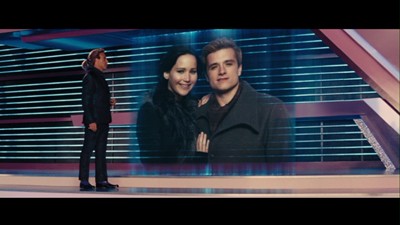 | 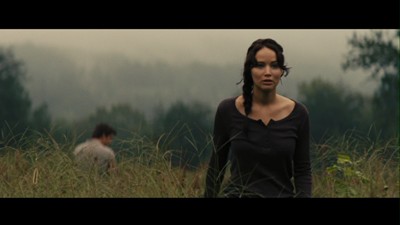 |
Catching Fire boldly roots into darker material by first centering on Katniss' mental integrity and moral constitution, delving deeper into the character's psyche than in The Hunger Games. Her experiences in the arena, the murder of other children and the joy derived from their brutality by the audience, manifest into a form of post-traumatic stress that the film actively explores, hinged on a blistering performance from Jennifer Lawrence as the burgeoning freedom fighter. The Oscar-winning actress' inherent heart-on-sleeve candor becomes crucial to realizing Katniss' internal trauma, commanded by the manic and fearful energy in her reactions as she sees violent images that aren't there and awakens in the night to harrowing dreams. There's a subtler melancholy behind her presence as well, though: the understated glances she shares with her maturing sister Prim (Willow Shields), her rekindled friendships with Peeta and Gale, and how she jolts her drunken mentor, Haymitch (Woody Harrelson, Zombieland), out of his stupor reveal a young woman bottled up with a cocktail of cynicism and desperation, justifiably unready for the challenges ahead.
Adapted from Collins' second book in ways that perhaps outdo even the text, those challenges consist of an uptick in the story's themes about authoritarian government and police enforcement, rendering a harsher dystopian atmosphere as Katniss and Peeta traverse the districts. Granted, director Lawrence can only go so far with depictions of brutality in a PG-13 film aimed at broader audiences, but Catching Fire certainly captures the bleakness and simmering intensity of a burdened nation on the brink of revolution, down to underscoring the volatile events -- the bloodshed -- catalyzing their fury. The work the production crew have done in shaping Central Georgia's locations to fit this bleak but arresting vision are constantly spectacular: the desolate and hopeless atmosphere of the industrial districts, held at gunpoint by white-clad peacekeepers, funnel towards the candy-coated center of privilege benefiting from their destitution, the Capitol. Where the first film emphasized the harrowing spectacle of the games with addled camerawork, the second focuses on the disparity and anxiety between social classes through Limitless cinematographer Jo Willems' steady, stunning gaze at Panem and its denizens.
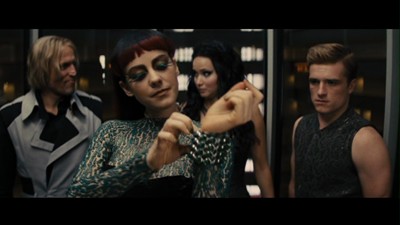 | 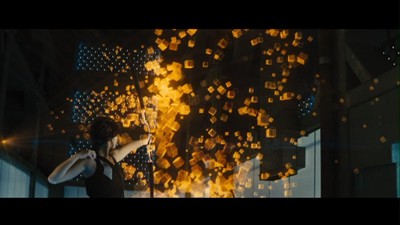 |
Director Lawrence has his own challenge to handle with the book's story, since it'd be easy -- and not unjustified -- to look at Catching Fire's return to the arena for more bloodshed as an auspicious rehash, in a franchise that already deals with the baggage of emulating the likes of Battle Royale in its design. Katniss' resignation to death and the participants in the Games themselves, all previous victors with their own idiosyncrasies, give the plot the alternate perspective needed to mask the similarity. Revisiting the media exploitation and pop-culture critiques on reality shows are made intriguing by Katniss' bleak self-assurance and the collective passion of the elder participants, while the building of alliances and training exercises invite those watching into the minds of past tributes. Clearly, there's more to them than meets the eye: Sam Claflin lends suspicious magnetism to the chiseled, primped gladiator Finnick, while Jena Malone's embodiment of the rebellious axe-wielding whackjob Johanna Mason adds a clever parallel to Katniss' quieter and stoic resistance. The road to the arena might be similar, but it's an entirely different ballgame once they're at the Capitol.
In the arena, all of Catching Fire's alternate attributes come to a head, leading to vastly more engaging and visually alluring action beats created by a wide array of dynamic threats, both human and not. The jump to the big screen aids the activity in Collins' text in becoming clearer, which could get overly hectic and jumbled at times. Francis Lawrence's prowess as an action director shines in the complex combination of practical and digital effects, coming together in the tropical aquatic atmosphere in fast-moving, dangerous ways. The renegade flames and dogs from the first film were only the tip of the iceberg: the tricks up the sleeves of new gamemaker Plutarch Heavensbee (a reservedly charismatic Philip Seymour Hoffman) play directly into the deadly reality-show spectacle that the narrative so richly critiques, the shock and awe at his fingertips adding visceral surprises around every corner. Yet it's all part of the book's thrilling beats, the script taking very few liberties with the way the games go down. Shot almost entirely with IMAX cameras for breathtaking scope, it's an exhilarating forty-five minutes that buries the previous film's arena experience (something that can't really be said about the books).

There's also a veil of mystery, of suspicious moves and countermoves, going on within the games in Catching Fire, building towards a bittersweet lead-in to the final chapter(s) of The Hunger Games saga, and a fruition point in Katniss' journey towards becoming the face of the uprising against the Capitol. Sticking close to the source material ensured that the film would, ultimately, end on a cliffhanger that leaves questions only answerable by the next installment and, without doubt, feeling like a bridge between installments. Yet, even under those limitations, this adaptation finds a way to visibly underline Katniss' personal development across this individual story, in a rewarding and inspiring final burst as the film's final words hang in the air. That's what happens with a clear grasp on the source material, and it's really exciting to behold how Francis Lawrence not only maintained the strengths and spirit from the franchise's origin point in a reputable sequel, but improved upon them in surprising, reverent ways that make one eager to storm the castle alongside this girl on fire in the next one.
The Blu-ray:
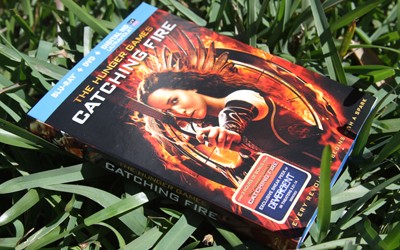 | 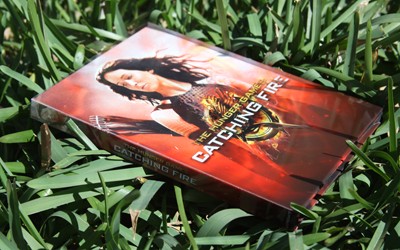 |
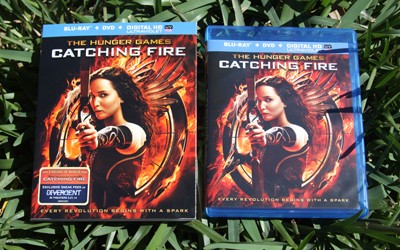 | 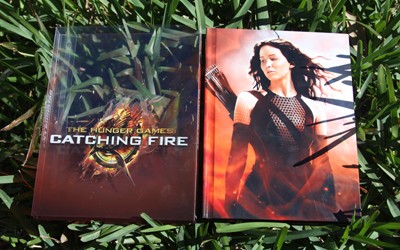 |
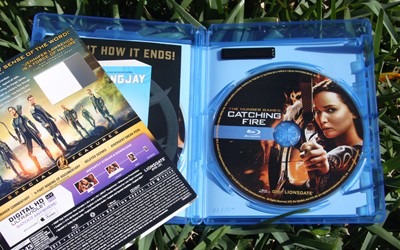 | 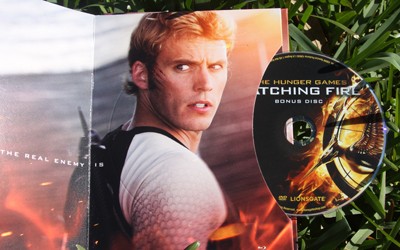 |

Click Each Link for Larger Photos of Target's Exclusive Blu-ray: Complete; Slipcover Off; DVD Bonus Disc.
The Hunger Games: Catching Fire has ascended onto Blu-ray from Lionsgate Home Entertainment in an commonplace two-disc arrangement, with Disc One being a loaded high-definition disc and Disc Two covering the DVD side for portability and legacy decks. The standard release is attractive but fairly standard with a cardboard slipcover replicating the theatrical poster artwork on the front and promotional shots on the back, carrying over the one-sheet design to the discs themselves. Slips promoting the books have been tucked under the hubs, along with an Ultraviolet Digital Copy slip for download purposes. Despite being generic, it makes for a fairly attractive regular package.
The folks at Target, on the other hand, have attempted to match the exclusive they released for the first Hunger Games with a deluxe package, which comes in a Digibook-like case containing tight cardboard-paper sleeves for the discs. Promotional images manipulated with fire accents and pinkish-red hues adorn the inside, featuring Katniss, Gale, Peeta, and Finnick. Unfortunately, this exclusive only comes in DVD-sized packaging, so it'll be a bit taller than the other release and might not fit on one's shelf. Furthermore, a Bonus Disc (discussed later in the review) fills up the third slot in the package; however, in keeping with the all-encompassing streamlined aims with the exclusive, the disc is a standard-definition DVD instead of a Blu-ray. Target's design may be distinctive and include extra material only found on this release, but it's got a few points going against it. Note that the first two discs, the Blu-ray and DVD, are identical between both copies, and that the DVD features a fixed 2.35:1 aspect ratio (along with the director's commentary and deleted scenes).
Video and Audio:
Those who were left feeling hollow after the purposefully erratic cinematography of The Hunger Games will really have their fill with Catching Fire, especially on Lionsgate's remarkable Blu-ray. There are two sides of the coin to the presentation, the first being standard Panavision Super-35 footage that photographer Jo Willems notes was shot on film because of the format's rich, somewhat flawed presence and grain structure, presented here at 2.35:1. The result, which covers everything except the lion's share of the footage during the games themselves, marvelously reflect that perspective: a very nice layer of film grain drapes over impressive fine detail in close-ups and in Katniss' modish garments; complex contrast during the stony industrial-district sequences and in the seasonal wildness stay solid and deep; and the incredibly vibrant colors once the setting reaches the Capitol and tribute training ground. Skin tones are responsive to the natural lighting captured in the photography, while the shine of metal and digital atmospheric touches -- snowflakes, fire embers, tumbling transparent blocks -- convey their textural touches without a hitch.
Then, shortly after Katniss enters the arena, the shift happens. Catching Fire's aspect ratio opens up to a screen-filling 1.78:1 to annotate when the IMAX footage begins, and it's one of the slickest and seamless ways of handling an in-film cinematography shift that I can imagine. From there, the already-strong picture quality goes up several notches in the tropical setting of the games, highlighted by unbelievably verdant foliage and radiant sun-drenched lighting. Textures are everywhere, from dark craggy walkways to grains of sand and trickles of sweat, and the elevated resolution and expanded viewing area render some of this format's most stunning images. There are one or two caveats, namely in how the darker scenes struggle with contrast at times, never to a point where details are completely crushed but enough to obscure. The beauty achieved through the IMAX footage vastly outweighs any reservations, though, resulting in some truly stunning moments between the characters that reveal exactly what the high-definition format is all about. Despite having one or two slight flaws, it's become one of my favorite transfers on the format ... and only partially for how it handles the ratio switch.
The Master Audio track has a lot to live up to while accompanying this visual treatment, but all eight channels of the 7.1 high-definition surround design are up to the task. The sounds of branches snapping and turkeys gobbling from multiple channels proves to be an accurate reflection of the immersive activity to come, where atmospheric effects maintain a crystal-clear, natural balance in replicating the bustle of revolutionary crowds and the lively sounds of a tropical jungle. Certain sound effects leading up to the arena hit forcefully, like the sound of a handgun and the pop of fireworks, while environmental effects like the rumble of fire and the rush of a train's movement showcase incredible awareness of the soundstage. Once in the arena, the activity gets more vigorous: the ferocious crash of waves, the searing of flesh, the fury of animals, and the pop of lightning aggressively, and successfully, give the lower-frequency channels a workout. Dialogue has its moments of sounding a little thin and imbalanced against the engaging score and insistent ambiance, but it's a mild hiccup in what's ultimately a fierce sonic delivery on Blu-ray. English, SDH, and Spanish subtitles are available, as well as a Spanish Dolby 5.1 option and a late-night optimized English 2.0 track.
Special Features:
 Commentary with Francis Lawrence and Nina Jacobson:
Commentary with Francis Lawrence and Nina Jacobson: This is one instance where I recommend watching the commentary after viewing the other making-of material, because the discussion from director Lawrence and producer Jacobson works better at filling in gaps not covered or lightly-covered elsewhere. Notably, early in the track, the pair touch on the one chunk of scenes that weren't shot around Georgia and Hawaii, from the biting cold of Jersey and a brief cameo to enhancing Katniss' PTSD with a pertinent addition. In general, this methodical and relaxed commentary almost intentionally pinpoints smaller elements that the big documentary avoids: recasting the cat, mildly rearranging and staying faithful to the book and its themes (including discussion about a certain pocket watch!), closely working with Suzanne Collins' extensive lore for atmosphere and geographical accuracy, focusing on the power in Jennifer Lawrence's performance, and discussing a unique choice for one of director Lawrence's favorite scenes. You have to tiptoe around one or two mild spoilers about the future Mockingjay films in the discussion, but it's nothing worth sweating over. Some material becomes redundant in communication with the documentary, but it's a very solid, relaxed, and insightful track that pays attention to a lot of the minor details that'll be appreciated by both film enthusiasts and fans of the book.
Making of Catching Fire (2:24:55, 16x9 HD):
When looking at the extras for Catching Fire, one might see the label "9-Part Making-Of Documentary" and expect this to be like other Blu-ray discs, where probably around a half-hour or so of press-kit material gets chopped up in segments and made to exaggerate its depth and elaboration. This isn't the case for Catching Fire, though: the documentary, roughly as long as the movie itself (longer if you don't consider the credits), edits together interviews and behind-the-scenes material for an incredible cogent, in-depth look at all the facets of assembling the film. Producer Nina Jacobson and director Francis Lawrence lead the charge touching on the material, usually offering straightforward introductions into individual topics -- casting, shooting locations, visual effects -- and then letting the BTS footage tell the story, often with the production team and actors elaborating on what's being discussed in between takes. The piece understands its target audience, rarely getting too technical with the content so they don't lose the attention of casual viewers, but you get a strong, appreciative sense of the work that went into Catching Fire once it's finished. Here are the timecodes for each segment:
| A New Kind of Hunger: Continuing the Saga (11:07) | Visual Vocabulary: Building a World (13:03) | Stirring Things Up: The Cast (18:01) |
| Fashion Forward: Costume, Make-Up & Hair (16:46) | Let it Fly: Production in Atlanta (15:19) | Moves and Countermoves: Stunts & Weapons (19:52) |
| Tick Tock: Production in Hawaii (14:36) | Threading the Needle: Post-Production (27:41) | The Revolution Lives: Reflections & Looking Forward (9:09) |
The most significant takeaway from this documentary comes in how they've morphed locations around Atlanta and central Georgia to fit Panem's dystopian atmosphere, both in their discovery of workable locations and the extensive usage of visual effects out of Double Negative's studio, complete with VFX progression and comparisons. Alongside that, the pieces also emphasize how tightly-knit this group of actors have become, how
 they've embraced Francis Lawrence's replacement of Gary Ross -- something openly discussed -- and how they've physically prepared for their roles through exhaustive combat training. Elizabeth Banks' passion for the trilogy of novels really shows alongside footage of her experimenting with Effie Trinket's attire, which feeds directly into discussion about new costume designer Trish Summerville and her excellent work, both her personal perspective and where she obtained garments externally.
they've embraced Francis Lawrence's replacement of Gary Ross -- something openly discussed -- and how they've physically prepared for their roles through exhaustive combat training. Elizabeth Banks' passion for the trilogy of novels really shows alongside footage of her experimenting with Effie Trinket's attire, which feeds directly into discussion about new costume designer Trish Summerville and her excellent work, both her personal perspective and where she obtained garments externally. While there's far more satisfaction and congratulation in the participants' tone, it's not entirely without some honest negativity about the production's demands, especially around capturing the arena sequences at a freezing, not-so-clean water park and the loudness of filming with IMAX cameras. Secondary details like the construction of Katniss' bow to the casting of the villainous tributes and getting WETA Workshop's assistance for animal VFX show off how in-depth the content becomes, along with a peek at the scoring and editing processes during post-production. And, indeed, there are a handful of new interview bits (three, I believe) with Philip Seymour Hoffman, about his fondness for the cast and his character. Altogether, with the clear behind-the-scenes footage and time-progression bits, it's a magnificent look at essentially every facet of this production.
Lionsgate Home Entertainment have also included a batch of Deleted Scenes (4:35, HD) with this release, which only garner some passing interest. There are only two of note: one involves an extended conversation between President Snow and gamemaker Plutarch Heavensbee about the origin of mockingjays (and the jabberjays appearing later in the film) that would've been a welcome addition, and another that features Philip Seymour Hoffman in a no-dialogue stretch of material where he walks towards a vault and torches an envelope. No, fans of the book: unfortunately, none of them involve a certain pocket watch, though the commentary confirms that they did actually shoot the scene and, validating a theory of mine, left it out because it would have been too big of a hint. A Sneak Peek at Divergent (6:43, HD) has also been thrown on the disc, essentially an extended version of the film's first trailer with interviews from director Neil Berger and author Veronica Roth elaborating on their enthusiasm.
Target's Exclusive Bonus DVD:
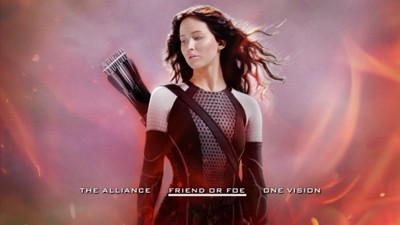 | 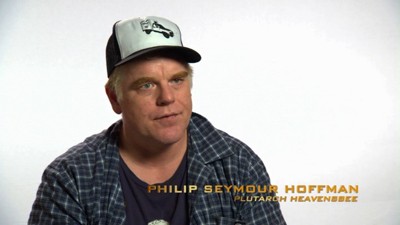 |
Target's bonus disc is a source of frustration, as parts of it are both recommendable to Blu-ray audiences and not. At first blush, the disc reveals three new sections to explore that mirror the documentary's rhythm of interviews and behind-the-scenes footage: The Alliance (14:27, 16x9) covers the central cast members and their experiences in continuing into a second film; Friend or Foe (18:24, 16x9) delves into characters new and old whose allegiance to the tributes is questionable; and One Vision (12:37, 16x9) hones in on adapting Suzanne Collins' novel as accurately as possible. Upon watching each one, some of the content becomes literally and figuratively redundant, where some of the interviews with the filmmakers and cast have been repeated from the making-of documentary, while becoming prone to retelling the plot and emphasizing the characters/themes. However, there are also some unique interview bits here, notably from Woody Harrelson in The Alliance about his enjoyable rapport with the cast and from Philip Seymour Hoffman in Friend or Foe about his experience in reading Collins' trilogy and working with Donald Sutherland. The entire forty-five minutes of content isn't really worth the time, but those savory new bits are.
Final Thoughts:
Let's keep this section relatively brief: Catching Fire is not only a better film than The Hunger Games, a surprise considering my misgivings towards Francis Lawrence as director, but it's also a better adaptation of the source that even comes dangerously close to overshooting Suzanne Collins' text. It's exhilarating, polished, and deftly telegraphs its themes about government oppression, media exploitation, and the inspiration of one person's voice within a dystopian nation. Jennifer Lawrence takes the strengths of her version of Katniss Everdeen to greater heights through her post-trauma psychosis and altered perspective on survival, deftly guiding her audience through the circus of a tribute's tour, the prospect of reentering the games, and shouldering the burden of becoming the face of an uprising. Lionsgate's Blu-ray is tremendous: the audiovisual quality rocks on many different levels, notably in how it handles an aspect ratio shift, and the supplements -- including a feature-length documentary and a commentary -- are extensive and pretty terrific. Chalk it up, either the standard release or the Target exclusive, to DVDTalk's Collector Series, because it's become a standout example of what the format's able to do with a popular blockbuster.
|
| Popular Reviews |
| Sponsored Links |
|
|
| Sponsored Links |
|
|
| Release List | Reviews | Shop | Newsletter | Forum | DVD Giveaways | Blu-Ray | Advertise |
|
Copyright 2024 DVDTalk.com All Rights Reserved. Legal Info, Privacy Policy, Terms of Use,
Manage Preferences,
Your Privacy Choices | |||||||











